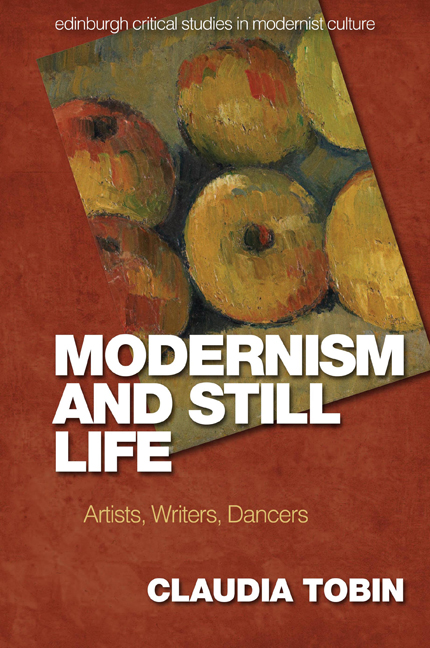Book contents
- Frontmatter
- Contents
- List of Figures and Plates
- List of Abbreviations
- Acknowledgements
- Series Editors’ Preface
- Introduction: ‘Nothing is really statically at rest’: Cézanne and Modern Still Life
- 1 ‘Quivering yet still’: Virginia Woolf, Roger Fry and the Aesthetics of Attention
- 2 Still Life in Motion
- 3 ‘Past the gap where we cannot see’: Still Life and the ‘Numinous’ in British Painting of the 1920s–1930s
- 4 ‘Inactive contemplation’: Wallace Stevens and Charles Mauron
- Conclusion: ‘On the very brink of utterance’: Aldous Huxley, Mark Gertler and Transfigured Things
- Bibliography
- Index
- Plate Section
1 - ‘Quivering yet still’: Virginia Woolf, Roger Fry and the Aesthetics of Attention
Published online by Cambridge University Press: 08 October 2020
- Frontmatter
- Contents
- List of Figures and Plates
- List of Abbreviations
- Acknowledgements
- Series Editors’ Preface
- Introduction: ‘Nothing is really statically at rest’: Cézanne and Modern Still Life
- 1 ‘Quivering yet still’: Virginia Woolf, Roger Fry and the Aesthetics of Attention
- 2 Still Life in Motion
- 3 ‘Past the gap where we cannot see’: Still Life and the ‘Numinous’ in British Painting of the 1920s–1930s
- 4 ‘Inactive contemplation’: Wallace Stevens and Charles Mauron
- Conclusion: ‘On the very brink of utterance’: Aldous Huxley, Mark Gertler and Transfigured Things
- Bibliography
- Index
- Plate Section
Summary
And there was Roger Fry, gazing at them, plunging his eyes into them as if he were a humming-bird hawk-moth hanging over a flower, quivering yet still. And then drawing a deep breath of satisfaction, he would turn to whoever it might be, eager for sympathy. (RF, p. 152)
With this vivid image, Woolf places us in the midst of what she described as the ‘bold, bright, impudent almost’ works of modern French art, sharing the excitement of Roger Fry, the art critic and painter, in his encounter with Post- Impressionist paintings (RF, p. 152). Woolf began research for her biography of Fry after his death in 1934 and it was published in 1940, some thirty years after he first introduced the English public to works by Cézanne, Van Gogh and Paul Gauguin at two famously audacious exhibitions, in 1910 and 1912, at the Grafton Gallery, London. Her description of Fry captures the intensity of his engagement with these works of art and constructs a model of aesthetic attention that will become the touchstone in this chapter. I suggest that compressed into this seemingly localised image is a complex of aesthetic and ethical concerns about attention and affect, sympathy and communication, receptivity and rapture, which pivot on the relationship between movement and stillness. Woolf‘s intimate observation of Fry's physical attitude – his immobile yet responsive state – demonstrates her own attentiveness to the dynamics of aesthetic encounters. The humming-bird hawk-moth at the centre of her vision of Fry has a wider resonance in her work: we shall see that she frequently embodies an aesthetic of attentiveness through the closely observed life of insects. Although the image makes a chronologically late appearance in her writing career, it offers a model through which to examine permutations of the ‘quivering yet still’, across a range of her fiction and non-fiction.
Woolf's fascination with ‘quivering stillness’ appears as early as in her second novel, Night and Day (1919). Wandering the gardens at Hampton Court, Cassandra experiences a feeling of inexpressible ‘bliss’, which permeates the ‘stillness’ and ‘brightness’ of the bucolic landscape: ‘[t]he quivering stillness of the butterfly on the half-opened flower, the silent grazing of the deer […], were the sights her eye rested upon and received as the images of her own nature laid open to happiness and trembling in its ecstasy’.
- Type
- Chapter
- Information
- Modernism and Still LifeArtists, Writers, Dancers, pp. 33 - 75Publisher: Edinburgh University PressPrint publication year: 2020



